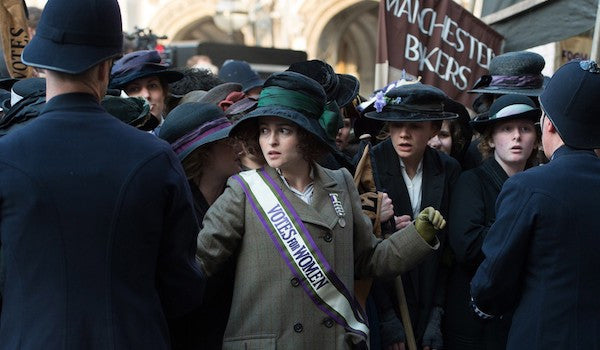
SOLDIERS IN PETTICOATS
With the UK election taking place today, we're looking back to Selvedge issue 67, where writer Nicola Donovan examined the role of textiles and colour in the suffragette movement of the late 19th and early 20th century...

In line with the current interest in the social, cultural and political upheavals of the early 20th century a new film highlights what became known as the Suffragette movement. Released in October Suffragette stars Meryl Streep as the figurehead of the fight for women’s right to vote, Emmeline Pankhurst, and also Carey Mulligan and Helena Bonham Carter as other prominent activists. Of interest to many viewers will be the depiction of contemporary costume, and in the film Streep as Pankhurst is shown dressed in subdued, respectable clothing accessorised with a silver medal complete with ribbon in the Suffragette colours of green, purple and white.

Although for some the word ‘suffragette’ might bring to mind images of Edwardian, middle class ladies chained to railings, or the horrific, grainy pictures of Emily Wilding Davison suffering fatal injuries from the King’s horse at the 1913 Derby, this resistance movement also operated as a sophisticated political organisation. Actually called by its members the ‘Women’s Social and Political Union’, who were themselves dubbed ‘Suffragettes’ by the Daily Mail, this organisation chose its colours as a means to covertly, and also overtly, indicate solidarity. The colours, which were chosen to represent dignity and freedom (purple), purity in public and private life (white) and hope and newness (green), created a sense of unity, which was something that many women of the time had not yet experienced.

Expression of this new commonality amongst women appeared in the form of textile crafts and is particularly visible in the embroidered, stencilled and appliquéd banners that identified ‘chapters’ of the Women’s Social and Political Union. The banners were used to promote The Causein processions and marches, or used as templates for printed leaflets. The collaboratively produced banners would carry beautifully crafted slogans such as ‘Votes for Women’, ‘Believe and You Will Conquer’ and the notorious call for violent protest – ‘Deeds, not Words’. Some banners were even woven and there are some intriguing examples of these held in the Women’s Library at the London School of Economics (LSE) Suffragette banner collection...
To read the rest of this article you can order your copy of Selvedge issue 67 here.

1 comment
Thank you for your interesting article. I have also read somewhere that the colours green, white and violet also stand for Give Women Votes.